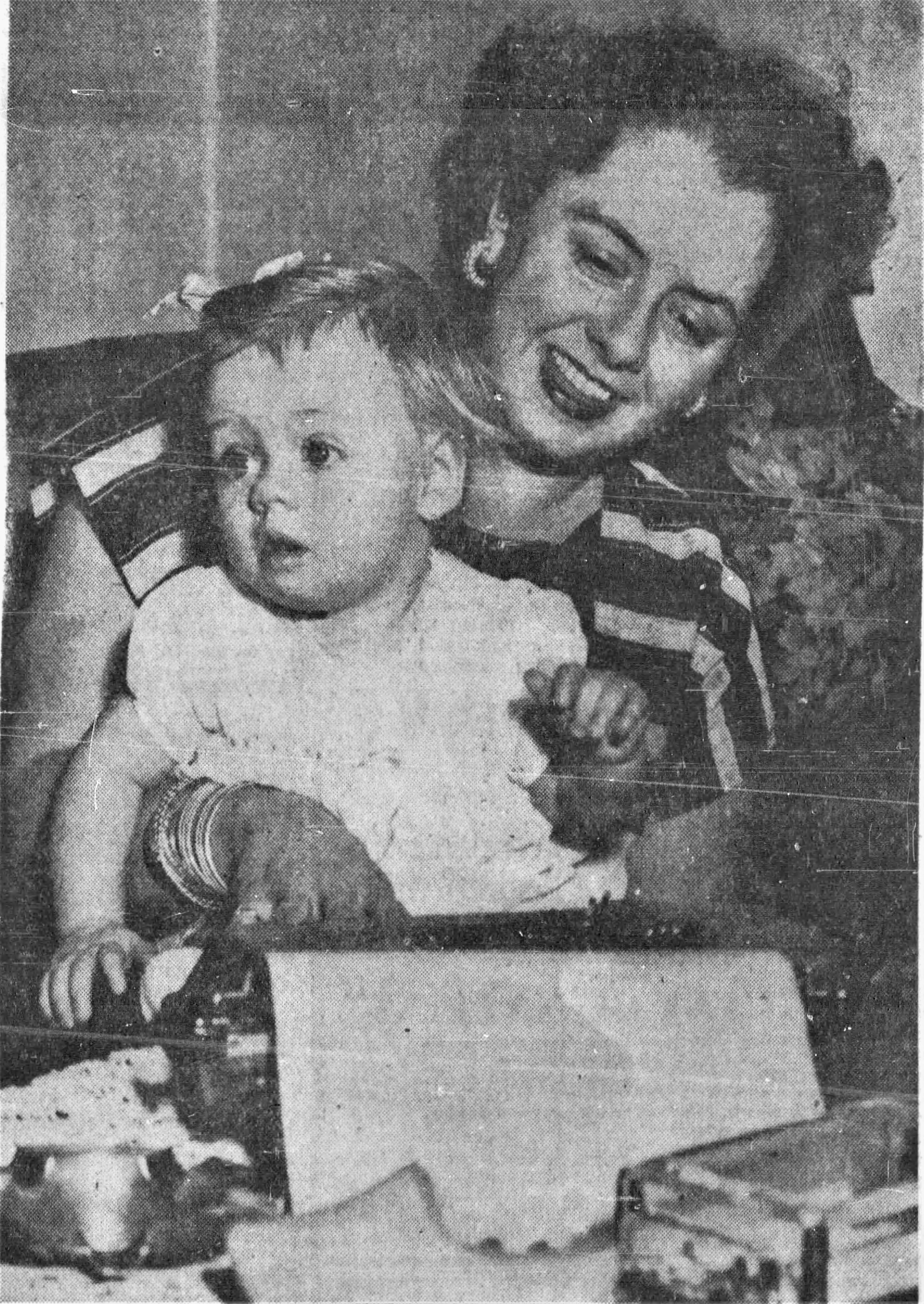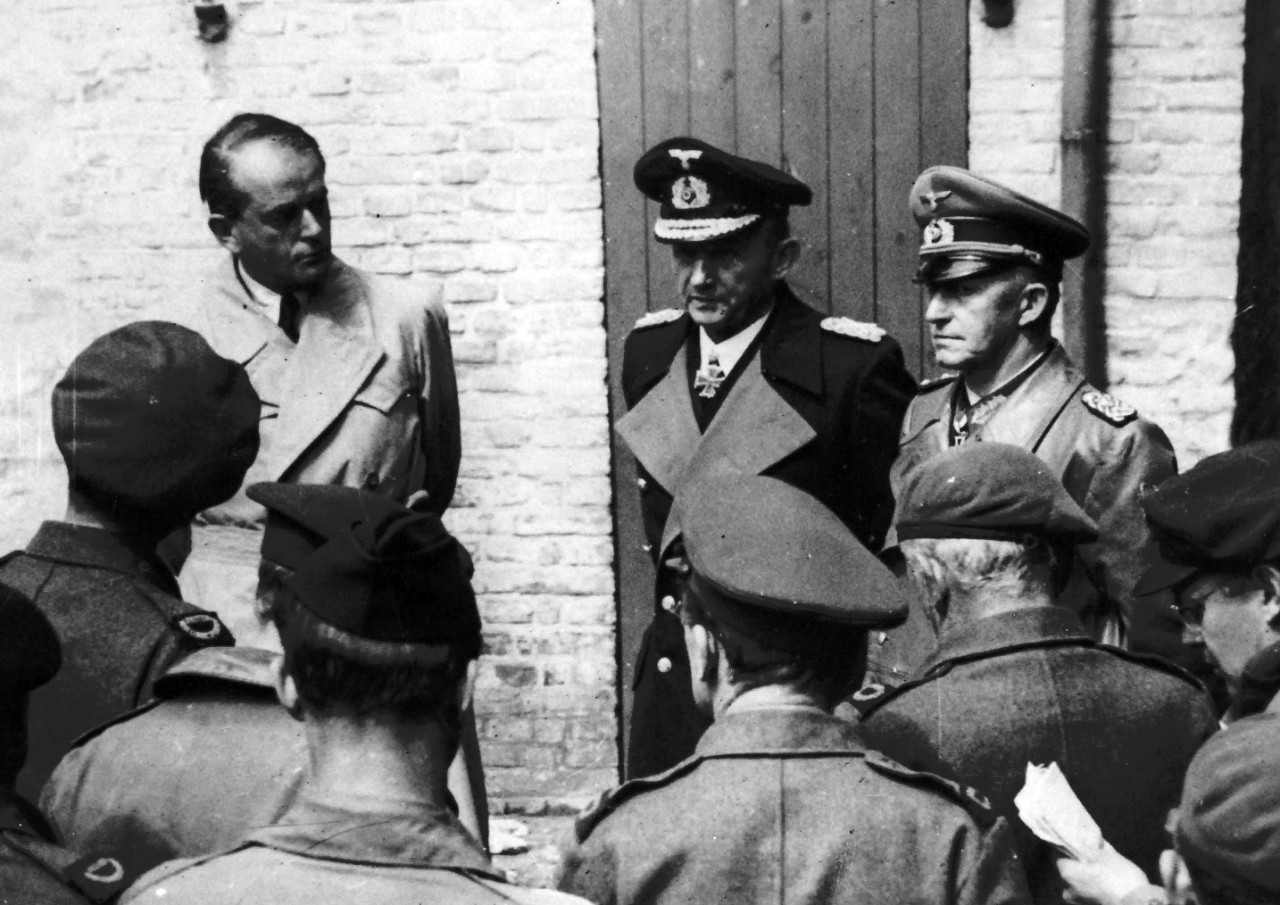Margaret Ecker spent a month in 1945 surrounded by Nazis. Happily, they were surrendering. Seventy-five years ago this weekend, the war correspondent from Vancouver was in the northeastern German seaport of Flensburg near the Danish border. She was one of only three journalists — a photographer and two reporters — aboard the liner Patria to witness the surrender of the last remnants of the Nazi government.
Ecker, who was 30, watched as three cars arrived at the gangplank. Out stepped Reichs president Karl Doenitz, whom Hitler himself chose as his successor in the hours before his suicide. The grand admiral was joined by chief of staff Col. Gen. Alfred Gustav Jodl, who had spent much of the war in East Prussia at the Wolf’s Lair, the command post for the Eastern Front, and by Admiral General Hans-Georg von Friedeburg, commander-in-chief of the remnants of the Kriegsmarine, German navy.
Even as Allied armies occupied Germany, remnants of Hitler’s regime sought to assert Nazi control over their homeland from headquarters at a sporting school in the Baltic Sea port. The self-proclaimed Thousand Year Reich came to an end inside a luxury ship’s lounge. It would have been a fit ending for a comic opera were not millions dead.
The only woman — and likely the only Canadian — at the final surrender was familiar with the Nazi leaders she had pursued with a pencil and notepad across Europe.
On May 23, 1945, she watched as the Germans waited in a bar with a floor of red tiles and walls panelled in blond wood.
“Doenitz, Jodl, and Friedeburg sat in the lounge chairs,” she wrote in a dispatch for the Canadian Press, “drumming the arms with their fingers, while their ornately uniformed and bemedelled chiefs of staff paced the room where they doubtless drank many toasts when the ship was Nazi headquarters.”
After six minutes, the American, British and Soviet military representatives entered the lounge. Gen. Lowell W. Rooks, from Walla Walla, Wash., nodded his head to indicate where the Germans were to sit at a white-covered table in the middle of the lounge.
“Each of you is to consider yourself a prisoner of war,” Gen. Rooks said.
Ecker noted in her dispatch that these were the words “which reduced men who aspired to be world masters to prisoners.”
She observed the Nazis — “sour-faced Doenitz, the livid Jodl in army uniform splashed with red the colour of his face and nose, the flabby Friedeburg” — with an unwavering eye.
“As Gen. Rooks spoke, Doenitz (and) Friedeburg slumped in their seats, shoulders and chins sagging. Jodl held himself upright and his mouth was a set line. He never ceased clasping and unclasping his bony, nervous hands. Gradually his face broke into blotches like red welts.”
After Jodl handed over a sheaf of papers, Gen. Rooks said, “Well, gentlemen, I bid you goodbye.”
With that, she wrote, “the three expressionless, defeated men shuffled from the room.”
Doenitz, the creator of Germany’s U-boat fleet for the Second World War, would be sentenced to 10 years’ imprisonment at the Nuremberg war trials. The same International Military Tribunal sentenced Jodl to death for war crimes; he was hanged on Oct. 16, 1946. Friedeburg did not last the day. He asked to use the bathroom.
When he did not soon emerge, a British guard rushed in to discover the admiral had swallowed cyanide.
Ecker was on board Patria because she had won a draw among correspondents. Another 15 reporters waited ashore.
What was billed by a Movietone newsreel as “Flensburg — The Last Roundup” was the last in a series of surrenders to Allied forces.
History remembers the most important of the ceremonies happening at the red brick schoolhouse at Reims, France, on May 7, which was celebrated the following morning as VE-Day around the world for Victory in Europe and the end of hostilities in that theatre of war.
Jodl and Friedeburg were present for the unconditional surrender of the German armed forces that morning. So, too, was Ecker, who had been a war correspondent for nine months and before that wrote dispatches from Britain since arriving overseas in the fall of 1943. She was in Paris when informed she should make her way to Supreme Headquarters Allied Expeditionary Force, headed by American Gen. Dwight Eisenhower, about 145 kilometres northeast of the French capital.
“We got the phone call and knew it was something big,” Ecker said the next day. “We drove out there, about 60 of us, and it was quite a jam in the schoolhouse, all of us pushing and shoving and leaning over each other’s shoulders to see what went on.”
Ecker was one of 17 correspondents allowed to witness the signing after pledging to keep the news secret for a day to allow Soviet leader Joseph Stalin to announce the surrender. One of them, Edward Kennedy,* of the Associated Press, decided to break the censorship by filing a bulletin whose first sentence read: “REIMS, France, May 7 (AP) Germany surrendered unconditionally to the Western allies and the Soviet Union at 2:41 a.m. French time today.”
It was the scoop of the year for which the wire service fired the reporter for violating the embargo. He had done so because he had heard the news broadcast on German radio and considered the matter not to be a military secret, but a political one. The wire service acknowledged mistreatment of their correspondent in 2012, a half-century after his death.
Barely noted at the time and ignored on the 75th anniversary this month was Ecker’s own remarkable achievement. At the end of a major theatre of war in a global conflagration that claimed the lives of millions of women, she was the only woman in the room when the German generals surrendered.
She “didn’t once think” about her role as the only woman witness to history, she told the Vancouver Province hours later, only that “I just knew that the biggest event I had ever seen or ever would write about in my life was taking place.”
During the war, Ecker interviewed British Gen. Bernard Montgomery, arrived at Buchenwald soon after the death camp was liberated, and toured the liberated Netherlands with Queen Wilhelmina. She had befriended the exiled monarch in Ottawa earlier in the war and got a regal invitation to join her on a tour, including eight hours spent in an amphibious vehicle to greet residents in flooded lands.
The writer was struck by the resilience of the Dutch.
“One I remember in particular — a woman whose little son had a wooden leg as the result of bombings,” Ecker told the Ottawa Citizen in 1946. “Her house had been blown to bits and her husband and another child killed. I had one chocolate bar in my bag and I gave it to the little boy. The tears came to his mother’s eyes. ‘It is the first time he has ever tasted candy,’ she told me.”
In 1947, the Dutch Queen named Ecker an officer of Order of the House of Orange, the first Canadian woman to be so honoured.
Another time, as battles were fought outside Leipzig in Germany, Ecker joined war correspondents in searching for another internment camp. Bullets whizzed overhead and they decided to turn back. After driving two miles they came across a shocked American soldier who informed them they were still three miles behind the German lines. Her other narrow escape came when she was bombed out of her quarters near Eindhoven in the Netherlands.

Margaret Alberta Ecker was born in Edmonton in 1915 to the former Margaret Corbett and Peter Ecker. The family moved to Vancouver when the girl was two. Her mother was heavily involved in club and United Church work, while her father was a lifetime member of the International Molders and Allied Workers Union, No. 281.
Margaret Ecker first became a reporter at the Ubyssey student newspaper and served as editor of the University of British Columbia’s Totem yearbook in her senior year of 1935-36. She reported for the Vancouver Sun, the Province, the Edmonton Bulletin and British United Press.
On Dec. 3, 1941, just four days before the Japanese sneak attack on the American fleet at Pearl Harbor, she married Bob Francis, a fellow reporter who had been born in England. He served during the war as Royal Canadian Air Force officer, as well as a correspondent, including filing a report from the D-Day landings. Ecker herself arrived in Normandy about eight weeks afterwards.
While she was overseas, she won a Canadian Women’s Press Club Award for a feature she had written about a man found paralyzed on a Toronto street. The man was treated under an incorrect name in the hospital while his wife searched fruitlessly for him. After two years, his left hand regained enough flexibility for him to write his name in pencil. Once again reunited with his family, he gained enough hand strength to be able to type, a skill he used to compose stories for pulp magazines. Ecker wrote that his true story was “stranger than the fictions he writes.”
The judge, Cornelia Otis Skinner, an American author and actress, said the article was “terse, vivid and with a justifiable emotional dip, but not a complete bath.”
She won again for a 1946 Chatelaine magazine article titled “Nostalgia” about the yearning ex-servicemen and women felt for the far-off lands they visited during war. The prize included a gold medal and $100.
After the war, she was an editor at the worker-owned Vancouver News-Herald. The couple operated a public-relations firm before travelling the globe as freelancers. They were visiting Spain’s Balearic islands in 1965 when Ecker died suddenly of heart failure attributed to cirrhosis of the liver. She was 50.
Her account of the German surrender at Reims, though mostly forgotten for three-quarters of a century, remains a testament both to her tenacity and to her literary prowess.
She was so young at the time that when Gen. Eisenhower first spotted her at the surrender ceremony, he said: “What’s that child doing here?”
She was there to witness history.
“The world conflict which Hitler had launched with such thunder ended with a whimper in the small stuffy room crammed with about 60 persons dripping with perspiration,” she wrote for Canadian Press. “The whole scene in itself was unbelievably mundane after years of war…”
The gravity of the moment was not lost on her.
“In the chill morning day, the first day of peace, our transport plane lifted us off Reims airfield, bound for Paris where we would try to write a story for which no words seemed appropriate. As the plane roared into the sky, made pink by the sunrise, pearly bits of mist clung to the lovely French countryside, giving the horizon for which we were heading an unreal ethereal quality. Peace was dawning at last in this part of the world.”
*Name corrected May 25 at 6:40 a.m. ![]()
Read more: Media

















Tyee Commenting Guidelines
Comments that violate guidelines risk being deleted, and violations may result in a temporary or permanent user ban. Maintain the spirit of good conversation to stay in the discussion.
*Please note The Tyee is not a forum for spreading misinformation about COVID-19, denying its existence or minimizing its risk to public health.
Do:
Do not: